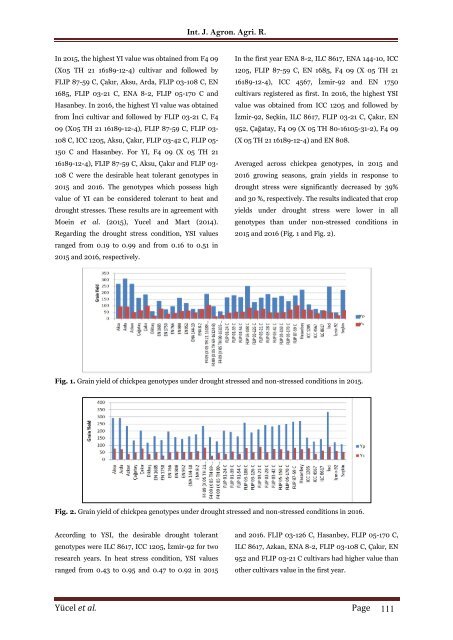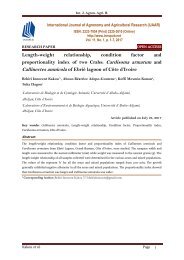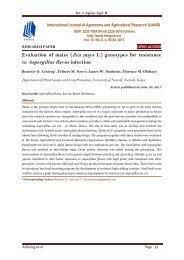Evaluation on drought and heat tolerance capacity of chickpea
Abstract Chickpea (Cicer arietinum L.) is one of the important legumes widely grown for dietary proteins in semi-arid Mediterranean climatic conditions. To evaluate the genetic diversity with improved heat and drought tolerance capacity in chickpea, thirty-four selected chickpea genotypes were tested under different field-growing conditions (rain fed winter sowing, irrigated-late sowing and rain fed-late sowing) in 2015 and 2016 growing seasons. A factorial experiment in randomized complete block design with 3 reps was conducted at the Eastern Mediterranean Research Institute Adana, Turkey. Based on grain yields under different growing conditions, the values of tolerance index, mean productivity, yield index, yield stability index, stress tolerance index, stress susceptibility index, and geometric mean productivity were calculated to identify economically higher-yielding chickpea genotypes with greater heat and drought tolerance capacity. There were highly significant differences observed among the tested chickpea genotypes response to drought and heat stresses. Besides, in both non-stress and stress conditions mean productivity, yield index, stress tolerance index, and geometric mean productivity, which highly positively significantly correlated with seed yields, were the best indices. Among the chickpea genotypes, the Aksu, Arda, Çakır, F4 09 (X 05 TH 21-16189), FLIP 03-108 were identified with a higher drought and heat tolerance capacity. Based on our field studies, it is suggested that the drought and heat tolerance indicators of plants can be used by breeders to select stress-resistant economically productive chickpea genotypes suitable to grow under Mediterranean climatic conditions.
Abstract
Chickpea (Cicer arietinum L.) is one of the important legumes widely grown for dietary proteins in semi-arid Mediterranean climatic conditions. To evaluate the genetic diversity with improved heat and drought tolerance capacity in chickpea, thirty-four selected chickpea genotypes were tested under different field-growing conditions (rain fed winter sowing, irrigated-late sowing and rain fed-late sowing) in 2015 and 2016 growing seasons. A factorial experiment in randomized complete block design with 3 reps was conducted at the Eastern
Mediterranean Research Institute Adana, Turkey. Based on grain yields under different growing conditions, the values of tolerance index, mean productivity, yield index, yield stability index, stress tolerance index, stress susceptibility index, and geometric mean productivity were calculated to identify economically higher-yielding chickpea genotypes with greater heat and drought tolerance capacity. There were highly significant differences observed among the tested chickpea genotypes response to drought and heat stresses. Besides, in both non-stress and stress conditions mean productivity, yield index, stress tolerance index, and geometric mean productivity, which highly positively significantly correlated with seed yields, were the best indices. Among the chickpea genotypes, the Aksu, Arda, Çakır, F4 09 (X 05 TH 21-16189), FLIP 03-108 were identified with a higher drought and heat tolerance capacity. Based on our field studies, it is suggested that the drought and heat tolerance indicators of plants can be used by breeders to select stress-resistant economically productive chickpea genotypes suitable to grow under Mediterranean climatic conditions.
Create successful ePaper yourself
Turn your PDF publications into a flip-book with our unique Google optimized e-Paper software.
Int. J. Agr<strong>on</strong>. Agri. R.<br />
In 2015, the highest YI value was obtained from F4 09<br />
(X05 TH 21 16189-12-4) cultivar <strong>and</strong> followed by<br />
FLIP 87-59 C, Çakır, Aksu, Arda, FLIP 03-108 C, EN<br />
1685, FLIP 03-21 C, ENA 8-2, FLIP 05-170 C <strong>and</strong><br />
Hasanbey. In 2016, the highest YI value was obtained<br />
from İnci cultivar <strong>and</strong> followed by FLIP 03-21 C, F4<br />
09 (X05 TH 21 16189-12-4), FLIP 87-59 C, FLIP 03-<br />
108 C, ICC 1205, Aksu, Çakır, FLIP 03-42 C, FLIP 05-<br />
150 C <strong>and</strong> Hasanbey. For YI, F4 09 (X 05 TH 21<br />
16189-12-4), FLIP 87-59 C, Aksu, Çakır <strong>and</strong> FLIP 03-<br />
108 C were the desirable <strong>heat</strong> tolerant genotypes in<br />
2015 <strong>and</strong> 2016. The genotypes which possess high<br />
value <strong>of</strong> YI can be c<strong>on</strong>sidered tolerant to <strong>heat</strong> <strong>and</strong><br />
<strong>drought</strong> stresses. These results are in agreement with<br />
Moein et al. (2015), Yucel <strong>and</strong> Mart (2014).<br />
Regarding the <strong>drought</strong> stress c<strong>on</strong>diti<strong>on</strong>, YSI values<br />
ranged from 0.19 to 0.99 <strong>and</strong> from 0.16 to 0.51 in<br />
2015 <strong>and</strong> 2016, respectively.<br />
In the first year ENA 8-2, ILC 8617, ENA 144-10, ICC<br />
1205, FLIP 87-59 C, EN 1685, F4 09 (X 05 TH 21<br />
16189-12-4), ICC 4567, İzmir-92 <strong>and</strong> EN 1750<br />
cultivars registered as first. In 2016, the highest YSI<br />
value was obtained from ICC 1205 <strong>and</strong> followed by<br />
İzmir-92, Seçkin, ILC 8617, FLIP 03-21 C, Çakır, EN<br />
952, Çağatay, F4 09 (X 05 TH 80-16105-31-2), F4 09<br />
(X 05 TH 21 16189-12-4) <strong>and</strong> EN 808.<br />
Averaged across <strong>chickpea</strong> genotypes, in 2015 <strong>and</strong><br />
2016 growing seas<strong>on</strong>s, grain yields in resp<strong>on</strong>se to<br />
<strong>drought</strong> stress were significantly decreased by 39%<br />
<strong>and</strong> 30 %, respectively. The results indicated that crop<br />
yields under <strong>drought</strong> stress were lower in all<br />
genotypes than under n<strong>on</strong>-stressed c<strong>on</strong>diti<strong>on</strong>s in<br />
2015 <strong>and</strong> 2016 (Fig. 1 <strong>and</strong> Fig. 2).<br />
Fig. 1. Grain yield <strong>of</strong> <strong>chickpea</strong> genotypes under <strong>drought</strong> stressed <strong>and</strong> n<strong>on</strong>-stressed c<strong>on</strong>diti<strong>on</strong>s in 2015.<br />
Fig. 2. Grain yield <strong>of</strong> <strong>chickpea</strong> genotypes under <strong>drought</strong> stressed <strong>and</strong> n<strong>on</strong>-stressed c<strong>on</strong>diti<strong>on</strong>s in 2016.<br />
According to YSI, the desirable <strong>drought</strong> tolerant<br />
genotypes were ILC 8617, ICC 1205, İzmir-92 for two<br />
research years. In <strong>heat</strong> stress c<strong>on</strong>diti<strong>on</strong>, YSI values<br />
ranged from 0.43 to 0.95 <strong>and</strong> 0.47 to 0.92 in 2015<br />
<strong>and</strong> 2016. FLIP 03-126 C, Hasanbey, FLIP 05-170 C,<br />
ILC 8617, Azkan, ENA 8-2, FLIP 03-108 C, Çakır, EN<br />
952 <strong>and</strong> FLIP 03-21 C cultivars had higher value than<br />
other cultivars value in the first year.<br />
Yücel et al. Page 111





